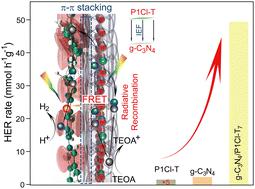当前位置:
X-MOL 学术
›
Energy Environ. Sci.
›
论文详情
Our official English website, www.x-mol.net, welcomes your feedback! (Note: you will need to create a separate account there.)
Direct Z-scheme polymeric heterojunction boosts photocatalytic hydrogen production via a rebuilt extended π-delocalized network
Energy & Environmental Science ( IF 32.5 ) Pub Date : 2022-10-26 , DOI: 10.1039/d2ee02380f Linpeng Xu 1 , Bining Tian 1 , Tianyue Wang 1, 2 , Ying Yu 2 , Yucheng Wu 1, 3 , Jiewu Cui 3 , Zhongnan Cao 3 , Jianhong Wu 2 , Weike Zhang 1 , Qi Zhang 4 , Jiaqin Liu 4 , Zhanfeng Li 2 , Yue Tian 1
Energy & Environmental Science ( IF 32.5 ) Pub Date : 2022-10-26 , DOI: 10.1039/d2ee02380f Linpeng Xu 1 , Bining Tian 1 , Tianyue Wang 1, 2 , Ying Yu 2 , Yucheng Wu 1, 3 , Jiewu Cui 3 , Zhongnan Cao 3 , Jianhong Wu 2 , Weike Zhang 1 , Qi Zhang 4 , Jiaqin Liu 4 , Zhanfeng Li 2 , Yue Tian 1
Affiliation

|
Carrier recombination involved in polymeric photocatalysts includes undissociated exciton decay and charge recombination, which are the major hindrance limiting their photocatalytic activities. Realizing highly efficient charge generation and separation simultaneously in one polymeric system is therefore a fundamental strategy for the potential success of solar-to-hydrogen conversion but remains a great challenge. Here, we develop a large π-delocalized direct Z-scheme polymeric heterostructure (g-C3N4/P1Cl-T) that synergistically integrates a two-dimensional (2D) donor–acceptor conjugated polymer (P1Cl-T) with g-C3N4. We demonstrate that the intermolecular π–π stacking successfully rebuilds the extended π-network over the whole polymeric heterojunction, thus facilitating full-visible-light absorption, exciton dissociation and charge transport. The combination of spectroscopic analysis and theoretical calculations reveals that both resonance energy transfer and Z-scheme charge transfer occur upon light illumination. With the intense synergy among the large π-delocalization, π–π stacking interactions and internal electric field, the g-C3N4/P1Cl-T photocatalyst shows an unprecedentedly high hydrogen evolution rate of ∼111.8 mmol h−1 g−1 with apparent quantum yields (AQYs) of 46.75% at 475 nm and 1.77% at 700 nm, which is about 48-fold higher than that of pristine g-C3N4 and tops those for all the previously reported polymer-based photocatalysts.
中文翻译:

直接 Z 型聚合物异质结通过重建的扩展 π 离域网络促进光催化制氢
聚合物光催化剂中涉及的载流子复合包括未解离激子衰变和电荷复合,这是限制其光催化活性的主要障碍。因此,在一个聚合物系统中同时实现高效的电荷产生和分离是太阳能转化为氢的潜在成功的基本策略,但仍然是一个巨大的挑战。在这里,我们开发了一种大的 π 离域直接 Z 型聚合物异质结构 (gC 3 N 4 /P1Cl-T),它将二维 (2D) 供体-受体共轭聚合物 (P1Cl-T) 与 gC 3 N 4协同集成. 我们证明了分子间 π-π 堆叠成功地重建了整个聚合物异质结上的扩展 π-网络,从而促进了全可见光吸收、激子解离和电荷传输。光谱分析和理论计算的结合表明,共振能量转移和Z型电荷转移都发生在光照下。由于大的 π 离域、π-π 堆积相互作用和内部电场之间的强烈协同作用,gC 3 N 4 /P1Cl-T 光催化剂显示出前所未有的高析氢速率,约为 111.8 mmol h -1 g -1在 475 nm 和 700 nm 处的表观量子产率 (AQY) 分别为 46.75% 和 1.77%,比原始 gC 3 N 4高约 48 倍,超过了之前报道的所有基于聚合物的光催化剂。
更新日期:2022-10-26
中文翻译:

直接 Z 型聚合物异质结通过重建的扩展 π 离域网络促进光催化制氢
聚合物光催化剂中涉及的载流子复合包括未解离激子衰变和电荷复合,这是限制其光催化活性的主要障碍。因此,在一个聚合物系统中同时实现高效的电荷产生和分离是太阳能转化为氢的潜在成功的基本策略,但仍然是一个巨大的挑战。在这里,我们开发了一种大的 π 离域直接 Z 型聚合物异质结构 (gC 3 N 4 /P1Cl-T),它将二维 (2D) 供体-受体共轭聚合物 (P1Cl-T) 与 gC 3 N 4协同集成. 我们证明了分子间 π-π 堆叠成功地重建了整个聚合物异质结上的扩展 π-网络,从而促进了全可见光吸收、激子解离和电荷传输。光谱分析和理论计算的结合表明,共振能量转移和Z型电荷转移都发生在光照下。由于大的 π 离域、π-π 堆积相互作用和内部电场之间的强烈协同作用,gC 3 N 4 /P1Cl-T 光催化剂显示出前所未有的高析氢速率,约为 111.8 mmol h -1 g -1在 475 nm 和 700 nm 处的表观量子产率 (AQY) 分别为 46.75% 和 1.77%,比原始 gC 3 N 4高约 48 倍,超过了之前报道的所有基于聚合物的光催化剂。



























 京公网安备 11010802027423号
京公网安备 11010802027423号